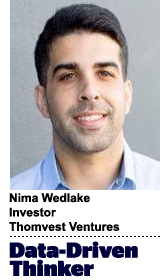 “Data-Driven Thinking” is written by members of the media community and contains fresh ideas on the digital revolution in media.
“Data-Driven Thinking” is written by members of the media community and contains fresh ideas on the digital revolution in media.
Today’s column is written by Nima Wedlake, investor at Thomvest Ventures.
When Snap announced its third quarter earnings last month, it reported $208 million in revenue and 178 million daily active users. The company missed revenue and user growth expectations by $30 million and 2 million, respectively, sending its stock price tumbling 16% after hours.
The lackluster earnings underscore the difficulty Snap faces in transforming its popular communication app into a viable advertising platform. These challenges are magnified because Snap is transitioning its ads business from a direct-sales model to an auction-based model, all while being scrutinized by Wall Street as a public company.
So how does Snap scale up its advertising business? Snapchat has become an ubiquitous communication tool used by more than 70% of 13- to 34-year-olds in the United States, France, United Kingdom and Australia. On average, users open the app 25 times and send more than 3.5 billion snaps per day.
The company has also begun developing original content with partners such as BuzzFeed, CNN and ESPN. Users have been receptive: Stay Tuned, a news show produced by NBC for Snapchat, reached more than 12 million US 13- to 24-year-olds in September.
But despite Snap’s highly engaged user base and content partnerships, it has struggled to scale its monetization efforts. Q3 revenue was only $1.17 per daily active user (DAU), about six times less than Facebook’s revenue per DAU of $7.55.
Snap’s advertising strategy borrows heavily from the Facebook playbook. As has been widely discussed, it operates a closed platform that is accessible to advertisers via an ads API and self-serve buying tools, forcing many advertisers to work outside preferred buying platforms to access Snapchat inventory.
The closed network strategy works when an ad platform can deliver enough scale and performance to justify the incremental costs of a direct-buying relationship. But Snap has yet to replicate Facebook’s massive scale, targeting capabilities and high performing ad formats. Most advertisers view Snap as a niche or experimental ad platform: 95% of marketers allocate less than 10% of their digital budgets to Snap, according to the RBC AdAge Advertiser Survey [PDF].
This means that Snap is operating a programmatic ad platform without enough demand to actually utilize the platform’s auction mechanics. As a result, average Q3 CPMs dropped a whopping 60% compared to 2016. A material percentage of Q3 programmatic impressions were uncontested auctions.
A potential solution would be to open up the platform to outside demand – at least in the short-term – to increase bid density. Doing so would help stabilize pricing and bring thousands of new advertisers to the platform. Even Facebook opened to outside demand for a period as the company scaled its monetization efforts (remember FBX?).
Ineffective Ad Formats
AdExchanger Daily
Get our editors’ roundup delivered to your inbox every weekday.
Daily Roundup
The looming existential question for Snap is whether its platform, in its current form, can ever be monetized effectively.
Snapchat’s young, devoted audience uses the app primarily as a communication tool. Similar messaging apps have been notoriously difficult to monetize. That’s why Facebook hasn’t scaled up its advertising efforts on WhatsApp and Messenger: Ad units on those properties aren’t performant relative to feed-based experiences such as Facebook and Instagram.
Snapchat’s primary ad unit – sponsored story ads – are interstitials placed at the end of videos as users tap through their messages. The ads are skippable, which has led to completion rates materially lower than industry average. That’s part of the reason why CPMs on Snapchat are lower – between $3 and $8 – than rates for video inventory on platforms like Instagram and YouTube.
The Path Forward
Long term, the company will need to find a balance between user experience and ad effectiveness.
Some steps it can take to do so include segregating the user experience to distinguish between interactions with close friends (messaging) and those with brands, influencers and media organizations (content consumption). Snap CEO Evan Spiegal recently wrote about “separating the social from the media” in the Snapchat app, which speaks to the company’s efforts to distinguish the core experiences available in the app.
For the messaging experience, Snap should focus on monetizing via its highly-native sponsored creative tools, such as custom geofilters and lenses.
And for the content consumption experience, Snap should implement a minimum view time before an ad unit can be skipped and make this inventory available to outside demand. Encouraging more of a “lean-back” user experience would allow for better content discovery and longer viewing times. The company has already announced its intention to build tools that enable influencers to more easily share content with a broader audience, which is a promising development.
Snap remains an extremely important platform for young audiences that are increasingly difficult to reach elsewhere. And despite less-than-stellar earnings, the company is still valued at $13 billion, which is a roughly 10-times forward revenue multiple. It also has more than $2 billion in the bank.
There are plenty of ways Snap can use its cash and stock to acquire ad tech assets that could help accelerate its monetization efforts, as it did with its purchase of Metamarkets several weeks ago.
The company still has the time and capital to develop its ads business, either organically or via acquisition. But the clock is ticking, and public market investors expect meaningful progress over the next several quarters.
Follow Thomvest Ventures (@thomvest) and AdExchanger (@adexchanger) on Twitter.











